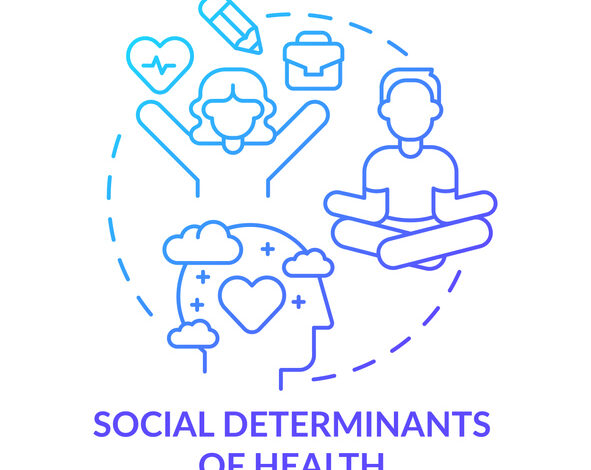
The Social Determinants of Mental Health: Case Management’s Latest Mandate
BY ELLEN FINK-SAMNICK, DBH, MSW, LCSW, ACSW, CCM, CCTP, CRP, FCM
Case managers are the stewards of resource management in their organizations. They monitor the moving parts of healthcare utilization from admission and readmissions, to the intensity of services utilized, severity of illness, and recurrent presenting needs. This level of responsibility means that case managers are critically aware of how much the social determinants of health (SDoH) impact the financial bottom line of their practice settings.
Healthcare organizations have aligned their annual priorities for over a decade with a steadily churning SDoH-targeted data engine. In October of 2012, the Hospital Readmission Reduction Program (HRRP) was implemented to address excess readmissions within 30 days. Many of these events were attributed to chronic co-morbid illness and underlying disparities in care. Yet, challenges remain despite the fierce efforts of every organization to mitigate these inequities. Case managers stands on the front lines of care, striving to expand their gaze toward a more wholistic health landscape. The workforce is being asked to mitigate even more pervasive gaps in treatment and intervention for patients and their families, while enhancing clinical, fiscal and operational outcomes for providers.
Advancing to a Wholistic Health Landscape
The past few years have witnessed a dramatic shift in the SDoH-landscape with expanded case management urgencies. Pandemic-related health inequities and chasms in care have contributed to a grand total of $4.3 trillion in National Health Expenditures (CMS, 2023). Rising admission rates have been identified across the globe with higher acuity of illness (Obuoubi et al., 2021; Zhang et al., 2020). Morbidity and mortality rates are on the rise with grossly higher disparities in premature death between Black and white racial groups in the U.S. and abroad Bundy et al., 2023; Lewer et al., 2020). The literature lens is massive!
Yet among the most pressing concerns for society and the workforce has been the burgeoning of mental health needs and their associated disparities. These issues have plagued an already over-burdened system, across sectors and populations. Keen attention is mandated across macro, meso and micro systems and levels of practice to manage current escalations in behavioral health (e.g., anxiety, depression), integrated care comorbidities (e.g., addiction, autoimmune disorders, chronic illnesses, COVID long-haul syndrome, insomnia), and more pervasive mental illness onset and exacerbation.
Advancing Case Management’s Wholistic Health Lens
Much has been written about the invasive costs of chronic diseases with the interweave of physical and behavioral health disparities a constant theme. After all, the mantra is clear that there is no health without mental health. While the integrated health and wellness of populations mandate critical attention, mental health disparities remain an integral element.
- >90% of national health expenditures in the U.S. are for persons living with comorbid chronic and mental health conditions (CDC, 2023).
- Social, emotional and psychological well-being directly impact all aspects of daily living, including physical health and increase the risk of asthma, diabetes, heart disease and substance use (Mack et al., 2021).
- Adult ED mental health visits have increased by >30% (Mao et al., 2023).
- Adults with severe mental illness (SMI) are more prone to chronic illnesses and die an average of 20 years earlier than populations without SMI (Luciano et al., 2022).
Mental health is among the largest drivers of unnecessary ED visits. The associated cost of boarding a patient with behavioral health needs in the ED has grown significantly in recent years. The $2,264 price tag per visit defined pre-pandemic by Schall et al. (2020) is now estimated to be upwards of five times higher that amount (Mao et al., 2023). Marginalized and disenfranchised populations are more likely to access community-based mental health versus private practitioners and programs, and are more likely to obtain mental health care emergently, with that care identified as a Band-Aid versus sustainable treatment solution (Fink-Samnick, 2021a, 2021b).
These latest realities do little to enhance the quality of mental health care and the Triple — if not Quadruple or Quintuple — Aim at issue. Physical, behavioral and psychosocial health are intertwined. Case managers understand that a whole person approach to health is the optimal model of care delivery. There is industry consensus that this comprehensive approach ensures better outcomes; a deliverable that case managers can relate to in the value-based era. Yet, despite the model’s promise, providing this level of integrated care remains one of the most challenging issues facing health systems and the industry today. Workforce development is challenging, as are reimbursement and consistent revenue capture (Barraclough et al., 2021). The model’s promise is unable to be leveraged for providers or the populations they serve.
Case Management Action to Address the SDoMH
Leverage the Evidence
The mental health of society and its accompanying disparities are a public priority. Correlations exist between physical health outcomes, the SDoH, and health inequities (e.g., race, ethnicity, education, socioeconomic status, access to care) (Compton and Shim, 2015; Williams, et. al., 2019). Case management’s workforce must use its interdisciplinary and interprofessional muscle to address chronic mental illness exacerbation and the impact for their patients and populations. For example, consider how unemployment derails a person’s access to mental health care. Persons who are under- and un-insured have far less access to care, whether for counseling, prescription medications or other treatment. The fierce advocacy and expertise of community health workers and psychopathology-brain trust of social work meld with the pathophysiology-savvy of nursing to assess, coordinate and plan for necessary patient care. The full power of case management’s workforce can make all the difference in ensuring sustainable treatment plans and more successful patient and provider outcomes Action item #1: We must leverage case management’s workforce continuum to address the SDoMH.
Shift the Focus and Narrative
Rampant institutional bias and stigma exists by providers who accept commercial insurance versus those honoring public and third-party insurers (e.g., Medicaid, Medicaid, dual eligibles); reduced reimbursement continues as a major obstacle for mental health providers. Provider deserts and shortages continue to be a major factor for mental health: 163 million people impacted in health provider shortage areas (HPSAs) across the U.S. (HRSA, 2023). These shortages impact 3,940 HPSAs across rural regions alone, and another 492 regions that are considered partially rural; some 75% of mental health HPSAs are rural (HRSA, 2023; Mack et al., 2022). Despite society’s pandemic-related technology advancement, techquity challenges persist. Persons in rural regions with pervasive challenges with Wi-Fi and broadband access (Mack et al., 2022). This article would expand considerably with deeper dive into this topic but keep this in mind for now. While telehealth has increased by over 236% from its pre-pandemic levels, not all persons have equitable access to care (Shaver, 2022).
These regions face constant challenges in recruiting and retaining behavioral health professionals, let alone access to requisite treatment. Patients deal with chronic issues of addiction, isolation and suicide; roughly twice as many suicides are identified in the most rural counties of the U.S. compared to urban counties (Mack et al., 2022). Populations struggle with access to the limited providers trained in behavioral health, and especially those who understand the unique intricacies of population-centric needs. This includes cultural sensitivity to managing the stigma of behavioral health within small communities. The mandate for providers who can render knowledgeable and concordant care for these communities is evident, yet still elusive.
In addition, gaps exist in the provision of culturally informed, concordant and inclusive treatment providers and interventions. While interventions such as motivational interviewing have been adopted to address patients who are less prone to behavioral change, this modality may not be effective with all populations. Implicit bias on the part of practitioners can be more norm than exception, particularly when treatment paradigms are ineffective. Practitioners resort to verbiage that blames the patient, such as “treatment non-compliant” versus shifting the treatment approach. Experts recommend transitioning treatment paradigms to those which assess and foster patient engagement and motivation to change their behaviors (Fink-Samnick, 2021, Williams, et. al., 2019). Action item #2: Shift the narrative to enhance focus on mental health inequities and reduce the associated patient blame, bias and stigma.
Respect Patient Autonomy
A focus on the SDoMH will promote a more informed approach to care by the care team, but also policymakers who advocate for necessary funding. Judgments, generalizations and false narratives can emerge, such as poverty equals increased substance use or intergenerational teen pregnancy and family violence, rather than poverty as a driver of trauma, victimization and other factors that exacerbate mental health conditions (Compton & Shim, 2015). A dedicated SDoMH perspective will promote less punitive approaches to mental health and treatment that are mandated by more vulnerable, disenfranchised and marginalized populations. Mental health stigma is a fierce factor that impacts populations engaging in treatment across the cultural scheme, whether, racial, ethnic, geographic, persons with cognitive and physical disabilities or individuals across the LGBTQIA++ community. Experienced, internalized and even anticipated stigmas easily obstruct more meaningful behavioral health interventions by those persons most in need (Cardoso, et al., 2020).
To combat these negative disruptors, case managers and the programs that employ them must use strength-based paradigms and interventions that account for individuals in the scope of their reality. These efforts enhance attention to cultural and other beliefs, including the value of mental health and treatment. Action item #3: View each person and population with objectivity and integrity.
Advance Workforce Training to Include Trauma-informed Care and Practices
Finally, there must be assessment and consideration of the vast scope of trauma in the context of overall health and mental health prevention and wellness. This scope encompasses historical, development, event and experiential traumas. Much can be learned from the latest generation of short-term tools that have been incorporated to approach chronic illness, and their role in enhancing more successful outcomes for patients. It is standard to assess an individual’s physical health and should be the norm to equally address behavioral health and related drivers, including trauma.
Integration of the Advanced Childhood Experiences (ACEs), and other trauma-formed mental health assessments target the unique person and population in the scope of their trauma and its impact on neurocognitive, social, and behavioral development. These factors exacerbate the emergence of assorted psychiatric diagnoses (e.g., attentive deficit disorder with hyperactivity, oppositional-defiant disorder, borderline and other personality disorders, major depressive disorder, bipolar (1 and 2), peri and post-partum depression). A growing list of tools enhance a case manager’s screening and assessment of patient behavioral health within healthcare settings, with options in Box 1.
Box 1. Behavioral Health Screening Tools
- Adverse Childhood Experiences Questionnaire (ACEs) Assessment of childhood and other trauma (MD+CALC, n.d.)
- AUDIT-C: Alcohol Use (MD+CALC, n.d.)
- CAGE Questionnaire: Assesses alcohol dependence (MD+CALC, n.d.)
- Columbia Suicide Severity Rating Scale (CSSRS): Assessment of foreseeable harm for suicidal ideation and intent (MD+CALC, n.d.)
- Coronavirus Anxiety Scale (CAS): Assesses dysfunctional anxiety associated with COVID-19 and the pandemic (MD+CALC, n.d.)
- DASS-21: Depression, Anxiety, Stress Screening
- Edinburgh Postnatal Depression Scale (EPDS): Screens for depression in the postnatal periods (MD+CALC, n.d.)
- GAD-7: Anxiety Screening (MD+CALC, n.d.)
- Geriatric Depression Scale (4,10, 15): Depression screening for older adults
- PHQ-2 and 9: General depression screening (MD+CALC, n.d.)
- PTSD Screen: Assessment for post-traumatic stress disorder
- Stanford Sleepiness Scale: Quantified subjective degrees of sleepiness
Reference: MD+CALC (n.d.) MD+CALC, Retrieved from https://www.mdcalc.com/#all
Action item #4: Use the tools to assess and address health and mental health prevention and wellness, as a matched set.
Amplifying SDoMH Action
Case management’s focused lens on both SDoH and SDoMH optimizes a strategic approach that is empowered by prevention, promotion and wellness. Employing a theoretical framework based on a system’s approach to care will fuel needed focus by all levels of practice, spanning macro (system), meso (community) and micro (patient) perspectives. These dynamic domains can get siloed and must be replaced by collaborative partnerships across sectors. In this way, attention to whole person, or wholistic care can be realized through initiatives that encompass the pathophysiology, psychopathology, and psychosocial circumstances of all patient populations. A lens focused on the collective expertise of upstream influencers (e.g., federal and state government, public policy, reimbursement, systematic racism) will minimize downstream disruptions to care access. This concerted effort will also spur needed mental health promotion in terms of funding, sustainable program development and implementation. One final Action item, #5: Case managers must lead the charge to:
- Build community collaborations that enhance access to needed intervention and treatment.
- Affirm attention to whole-person care models.
- Advocate for policies that drive sustainable funding and reimbursement of providers, practitioners and programs.
- Commit to dedicated attention to the SDoMH.
The CMSA standard of practice for resource management (G) affirms the case manager’s role in advocating for the SDoMH:
“The professional case manager should integrate factors compliant with requisite employer standards regarding patient access, choice, cost, health equity, quality and safety…(and) should document evidence of aligning the most effective and efficient use of health and behavioral health services and financial resources when designing a plan of care.” (CMSA, p. 27).
All stakeholders of case management deserve the profession’s maximum efforts to practice at the top of their scope. This includes advocacy, assessment, intervention, planning, monitoring and coordinating the highest quality care that yields cost-effective outcomes, especially for society’s most vulnerable consumers (CMSA, 2022). Any lesser quality is unethical and fails to heed the established resources that solidify case management practice.
References
Alegría M, NeMoyer A, Falgàs Bagué I, Wang Y, Alvarez K. Social Determinants of Mental Health: Where We Are and Where We Need to Go. Curr Psychiatry Rep. 2018 Sep 17;20(11):95. doi: 10.1007/s11920-018-0969-9. PMID: 30221308; PMCID: PMC6181118.
Barraclough, F., Smith-Merry, J., Stein, V., & Pit, S. (2021). Workforce Development in Integrated Care: A Scoping Review. International journal of integrated care, 21(4), 23. https://doi.org/10.5334/ijic.6004.
Bundy JD, Mills KT, He H, LaVeist TA, Ferdinand KC, Chen J, He J. Social determinants of health and premature death among adults in the USA from 1999 to 2018: a national cohort study. Lancet Public Health. 2023 Jun;8(6):e422-e431. doi: 10.1016/S2468-2667(23)00081-6. PMID: 37244672.
Case Management Society of America (CMSA) (2022). Standards of practice for case management. CMSA, Brentwood, TN.
Centers for Disease Control and Prevention (CDC) (2023). Health and economic costs of chronic illness, National center for chronic disease prevention and health promotion; Retrieved from https://www.cdc.gov/chronicdisease/about/costs/index.htm.
Centers for Medicaid & Medicare Services (CMS) (2023). National health expenditures fact sheet; Retrieved from https://www.cms.gov/research-statistics-data-and-systems/statistics-trends-and-reports/nationalhealthexpenddata/nhe-fact-sheet.
Compton, M.T., & Shim, R.S. (2015). The social determinants of mental health. American Psychiatric Association.
Fink-Samnick E. (2021a). The Social Determinants of Mental Health: Definitions, Distinctions, and Dimensions for Professional Case Management: Part 1. Professional case management, 26(3), 121–137. https://doi.org/10.1097/NCM.0000000000000497.
Fink-Samnick E. (2021b). The Social Determinants of Mental Health: Assessment, Intervention, and Wholistic Health Equity: Part 2. Professional case management, 26(5), 224–241. https://doi.org/10.1097/NCM.0000000000000518.
Health Resources & Services Administration (HRSA). (2023). Health workforce shortage areas, Mental Health; data.HRSA.gov. Retrieved from https://data.hrsa.gov/topics/health-workforce/shortage-areas.
Lewer, D., Jayatunga, W., Aldridge, R.W., Edge, C., Marmot, M., Story, A., & Haywar, A. (2020). Premature mortality attributable to socioeconomic inequality in England between 2003 and 2018: an observational study. Lancet Public Health. 2020 Jan;5(1):e33-e41. doi: 10.1016/S2468-2667(19)30219-1. Epub 2019 Dec 5. Erratum in: Lancet Public Health. 2020 Jan;5(1):e18. PMID: 31813773; PMCID: PMC7098478.
Luciano, M., Pompili, M., Sartorius, N., & Fiorillo, A. (2022). Editorial: Mortality of people with severe mental illness: Causes and ways of its reduction. Frontiers in psychiatry, 13, 1009772. https://doi.org/10.3389/fpsyt.2022.1009772.
Mack, B., Whetsell, H., & Graves, J.M (2022). Mental health in rural areas; National Rural Health Association Policy Brief; February 2022; Retrieved from https://www.ruralhealth.us/advocate/policy-documents.
Mao, W., Shalaby, R., & Agyapong, V. I. O. (2023). Interventions to Reduce Repeat Presentations to Hospital Emergency Departments for Mental Health Concerns: A Scoping Review of the Literature. Healthcare (Basel, Switzerland), 11(8), 1161. https://doi.org/10.3390/healthcare11081161.
Obuobi, S., Chua, R.F.M., Besser S.A., Tabit, C.E. (2021).Social determinants of health and hospital readmissions: can the HOSPITAL risk score be improved by the inclusion of social factors? BMC Health Serv Res. 2021 Jan 4;21(1):5. doi: 10.1186/s12913-020-05989-7. PMID: 33397379; PMCID: PMC7780407.
Reibling, N., Beckfield, J., Huijts, T., Schmidt-Catran, A., Thomson, K.H., Wendt, C. (2017). Depressed during the depression: has the economic crisis affected mental health inequalities in Europe? Findings from the European Social Survey (2014) special module on the determinants of health. Eur J Public Health. 2017 Feb 1;27(suppl_1):47-54. doi: 10.1093/eurpub/ckw225. PMID: 28355641.
Schall, M., Laderman, M., Bamel, D., Bolender, T. (2020). Improving Behavioral Health Care in the Emergency Department and Upstream. IHI White Paper. Boston, Massachusetts: Institute for Healthcare Improvement.
Shaver J. (2022). The State of Telehealth Before and After the COVID-19 Pandemic. Primary care, 49(4), 517–530. https://doi.org/10.1016/j.pop.2022.04.002.
Williams, M.T., Rosen, T., Kramer, J.W. (2019). Turner, E.A., Malone, C.M., & Douglas, C. Chapter 2, Barriers to mental health treatments for african americans: applying a model of treatment initiation to reduce disparities, in Eliminating race-based mental health disparities. Context Press.
Zhang, Y., Zhang, Y., Sholle, E., Abedian, S, Sharko, M., Turchioe, M.R., Wu, Y., & Ancker, J.S. (2020). Assessing the impact of social determinants of health on predictive models for potentially avoidable 30-day readmission or death. PLoS One. 2020 Jun 25;15(6):e0235064. doi: 10.1371/journal.pone.0235064. PMID: 32584879; PMCID: PMC7316307.
Dr. Ellen Fi nk-Samnick, DBH, MSW, LCSW, ACSW, CCM, CCTP, CRP, FCM, is an award-winning industry entrepreneur. Her focus is on interprofessional ethics, wholistic health equity quality, trauma-informed leadership, and competency-based case management. She is content-developer professional speaker, author, and educator with academic appointments at Cummings Graduate Institute of Behavioral Health Studies, George Mason University, and the University of Buffalo School of Social Work. Ellen serves in national leadership and consultant roles across the industry. Further information is available on her LinkedIn Bio or her website.
nk-Samnick, DBH, MSW, LCSW, ACSW, CCM, CCTP, CRP, FCM, is an award-winning industry entrepreneur. Her focus is on interprofessional ethics, wholistic health equity quality, trauma-informed leadership, and competency-based case management. She is content-developer professional speaker, author, and educator with academic appointments at Cummings Graduate Institute of Behavioral Health Studies, George Mason University, and the University of Buffalo School of Social Work. Ellen serves in national leadership and consultant roles across the industry. Further information is available on her LinkedIn Bio or her website.
IMAGE CREDIT: ISTOCK.COM/BSD STUDIO




